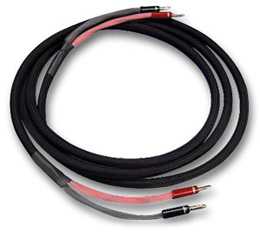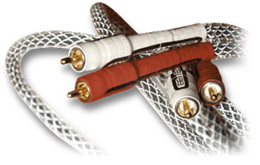 BetterCables Silver Serpent
Audio Interconnects and Premium Speaker Cables BetterCables Silver Serpent
Audio Interconnects and Premium Speaker Cables
I’m not all that fond of audio cable. Frankly, I find
it maddening to think that a few feet of wire can make a difference in a hi-fi system --
but it can. When you spend your money on something like a DVD player, you understand what
you're paying for and you get a product with a remote, pretty lights, and lots of parts
inside the box. Audio cables, by comparison, aren’t quite as exciting, and in many
cases they can be extremely expensive, making their value questionable.
The problem is that choosing the wrong cable can degrade
the sound of the best electronics. I suppose it wouldn’t be so bad if the list of
cable choices wasn’t so long, or the interactions between cable and electronics
weren't so complicated. Inductance, resistance, and impedance -- jeez, you'd think a
degree in electrical engineering was mandatory to simply listen to your favorite tunes!
Why can’t someone just offer a neutral cable at a price that won’t cause your
significant other -- or you -- to question your sanity?
Enter Brad Marcus, co-founder and president of the
Internet-based BetterCables brand of audio and video interconnects. Since 1999,
BetterCables' mission statement has been to design sonically neutral, yet affordable cable
solutions for audio and video devices that would compete favorably with the more expensive
high-end brands. And the company offers an impressive six-month satisfaction policy that
guarantees buyers' money back if they don’t find the cables to their liking. This
pledge is a nice touch -- if only other manufacturers would consider such a policy, maybe
the trauma of buying expensive cable would be lessened.
The products under review are the Silver Serpent
interconnects (priced at $79.95 for a .5-meter pair with RCA connectors) and the Premium
speaker cables (priced at $139.95 for a three-meter pair with spade connectors).
Considering what you can spend on cables today, these cables can be considered affordably
priced.
Money where it counts
The no-nonsense philosophy of this Virginia-based company
was apparent in the way the cables were delivered. There is no gold-plated box, no velvet
bag, no cortege of 25 white horses to add marketing melodrama to the presentation. Just a
couple of transparent zip-lock bags sporting plain, neatly printed stickers.
The cables seem well made and are relatively slender in
profile. The silver jacket and red-rubber shrink terminations on the Silver Serpent
interconnects did offer a bit more eye-catching glamour when compared to the black-net
jacket of the Premium speaker cable. But judging a cable on its looks seems a bit
ridiculous, especially if your living circumstances mandate concealment behind furniture.
In this circumstance, the highly flexible nature of the analog interconnects made them
easy to install within the cramped space behind my entertainment center. Even the speaker
cables, which were nearly twice the diameter of the interconnects, were exceedingly easy
to manage without any danger of crimping their meaty conductors.
 Overall quality control
for both the interconnect and the speaker cable proved to be pretty good, other than a
Vampire banana plug that refused to put the bite on two different styles of five-way
binding posts, and netting that separated from one of the screw-on termination jackets of
the same banana. Simply spreading the banana connector with a jeweler’s screwdriver
did the trick in remedying the lack of grip, while a small piece of electrical tape kept
the speaker cable's netting in check. Overall quality control
for both the interconnect and the speaker cable proved to be pretty good, other than a
Vampire banana plug that refused to put the bite on two different styles of five-way
binding posts, and netting that separated from one of the screw-on termination jackets of
the same banana. Simply spreading the banana connector with a jeweler’s screwdriver
did the trick in remedying the lack of grip, while a small piece of electrical tape kept
the speaker cable's netting in check.
The Silver Serpent interconnect utilizes a pure-copper
center conductor, which is coated with 99.9999% pure silver. Like many silver-coated
designs, the intent is said to reduce skin effect, or the tendency of high frequencies to
ride the outermost surface of the conductor. Skin effect reportedly can cause
time-alignment problems, which in turn contribute to smearing and an overall lack of
cohesiveness between low, mid, and high frequencies. A copper braid offers 95% coverage of
the cable. RCA connectors are solidly built and slim enough to fit into tight quarters.
The Premium speaker cable utilizes four 14AWG
ultra-pure-copper conductors twisted in pairs, which yields an overall wire gauge of
11AWG. The spade connectors (or banana plugs for a $40 premium) are hand-soldered to
the cable using silver solder.
I connected the BetterCables between my Harman/Kardon AVR
510 receiver and Marantz DR6050 CD player/recorder. Speakers included a pair of NHT’s
new ST4 floorstanding towers and my Cambridge SoundWorks Newton MC300 bookshelf speakers
minus the low-end support of my CSW P1000 sub. Per the manufacturer's advice, I allowed
the cables to burn in for approximately 40 hours before sitting down for a serious
audition.
Listening
By the manufacturer's own admission, the CSW Newton Mc300
speaker system is designed to be compatible with a wide assortment of mid- and entry-level
audio products. And while the sonic quality can be best described as slightly laid-back
and tolerant, this does not restrict the system's ability to show differences between the
sound of ancillary gear. Using my el cheapo 14AWG Home Depot wiring and some inexpensive
CSW interconnects didn’t seem to make the Newton system sound bad -- but improving
the cables improved the system. When I hooked up the BetterCables, the system displayed
differences.
Given the Newton MC300 speakers' personality, I anticipated
very little improvement when partnering them with the BetterCables, so I was surprised to
hear distinct improvements. The Newtons continued to be laid-back and forgiving,
but the new cable revealed more detail and greater clarity across the speakers’
frequency response. Rusted Root’s hit "Send Me Away" from When I Woke
[Uni/Mercury 522713] displayed more energy and faster attack on drum hits, and there was
less grain and stridency on potentially hard vocals. Sibilants exhibited less sizzle,
while plosive sounds were less spitty. Music and vocals, like those on Duncan Sheik’s
self-titled debut album [WEA/Atlantic 82879], had more of a liquid texture, which lent the
close-mic’ed compositions a relaxed room-filling quality without loosing any of their
snap. By comparison, the Home Depot cables introduced a much drier, less-crisp quality
that sucked some energy from the performances, while the broad, full image seemed spottier
across the soundstage.
The Newton MC300 speakers' limited bass capability
didn’t allow me to judge sub-frequency extension below about 70Hz. However, there was
a good deal of added detail in the lower midbass that made tracks off drummer Dave
Weckel’s energetic Master Plan [Uni/GRP 9619] sound more open and tight, with
drum solos that moved consistently, and seamlessly across both speakers. I also found the
attack and snap of stick against skin to have less of an edge.
One may conclude that most of what I was hearing was a side
effect of a cable possessing a rounded-off high end. Of course it could also be the
personality of the CSW’s taking command. With the NHTs sitting patiently in the
corner I wondered what effect the BetterCables might have on their extended, sometimes
relentless high frequencies.
There was no denying the marked improvement that adding the
BetterCables provided NHT’s ST4. Despite being cut from a slightly more forgiving
cloth than its SuperTwo predecessor, the ST4 still possesses the trademark transparency
that characterized the company’s goal of absolute sonic disclosure. The problem with
this approach is the speaker’s tendency to get a bit harsh with many decent
recordings.
The biggest difference I heard between the CSW/Home Depot
cables and BetterCables appeared while listening to Jean Michel Jarre’s classic Zoolook
[Sony XCD488140]. A recording that has its share of strident synthesizers, this 20-bit
remastering will induce a moderate level of listening fatigue if given the chance.
Let’s just say that with the Home Depot/CSW cables in place, my head started aching
around "Woolloomooloo" -- ouch. When the BetterCables were inserted, however,
the changes were instantly apparent. Electronic chirps and buzzes no longer had the
annoying edginess I winced at with the previous cables. This dissonance allayed, the NHTs
were able to flaunt their excellent imaging abilities and reveal Zoolook’s
rich ambient soundscape, which I proceeded to enjoy immensely.
A more refined, less etched, top end wasn’t the only
effect the BetterCables’s had on the ST4s. Midrange exhibited the same increase in
detail that was apparent with the CSW speakers -- albeit the NHTs did offer a more forward
presentation, with a bit more nuance in the midbass. These improvements also allowed live
recordings to take on a more realistic tonality. Voices were more palpable, percussion
demonstrated a more natural decay, with less ringing, and the sounds coming from an
upright bass were pleasingly plump without being fat or slow in their pacing.
Priced right, but do they sound right?
Where the CSWs sounded thicker in their tonality, the NHTs
sounded leaner, with a smoother edge. Like the difference between rich hot chocolate and a
good cup of Starbuck’s coffee, an individual’s preference for one or the other
speaker is a matter of taste. That the BetterCables actually added to my listening
pleasure was a fact with either speaker.
These cables did an excellent job adding to the overall
enjoyment of my system, and would make an excellent upgrade over basic cabling. What' s
more, they offer the GoodSound! reader a cabling option that won’t cause too
much undue financial stress. Who knows? Maybe even a little ol’ cable skeptic like me
might break down and pick up a set.
Price of equipment reviewed
|